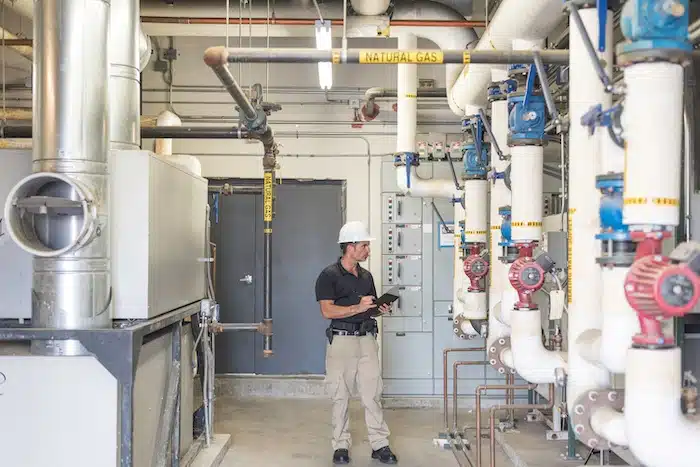Tariffs and the New Rules of Resilience in Commercial Service
The tariffs announced earlier this month have now been paused for 90 days. What will happen next? We can’t be sure. But one thing is clear: contractors need to plan for change, not just respond to it.
For fire protection and mechanical contractors, resilience means having the right systems in place to stay steady when external conditions shift. It’s not just about absorbing cost changes, it’s about staying flexible, communicating clearly, and keeping your operations running smoothly.
In this article, we’ll explore effective ways for contractors to stay strong, even during uncertain times.
How Trade Policy Affects Contractors
Tariffs affect contractors in many ways. The problems often start with suppliers and reach all the way to the jobsite. Here’s how:
- Parts costs become more unpredicatbale. Many key parts—like HVAC units, pumps, valves, or fittings—are made in or include parts from other countries. Tariffs can raise the cost of these items by 10% to 40%, or even more in some cases.
- Projects can take longer. Tariffs can slow down supply chains, especially when ordering big equipment. Delays mean missed deadlines.
- Profits get smaller. If you already agreed to a price and then new tariffs are implemented, you might lose money if your costs go up.
- Customer communication is more important than ever. Higher prices and missed timelines are hard to explain unless you’re open and honest about what’s going on.
How Contractors Can Respond to (Potential) Tariffs
1. Focus on Regular, Preventive Service
Relying too much on emergency jobs can hurt your bottom line, especially when parts are expensive or hard to get quickly. That’s why many contractors are moving toward planned, recurring maintenance.
This kind of work helps you:
- Reduce urgent parts ordering and inventory risk.
- Lock in recurring revenue.
- Build long-term relationships with clients.
- Gain more control over when, where, and how parts are sourced.
Predictable work leads to steady profits and smoother operations.
2. Embrace Dynamic Pricing Models
Fixed prices can be risky when costs are changing fast. Instead, some contractors use cost-plus or time-and-materials pricing for certain jobs. This gives them room to adjust prices as needed.
Here are some tips:
- Add language in contracts that allows for price changes
- Show labor and materials separately in your quotes
- Explain to customers how this protects both sides when prices change
3. Improve How Work Gets Done
When prices go up, you can protect your business by working smarter. Small changes can make a big difference.
Try to:
- Fix things right the first time to avoid repeat visits
- Plan routes better to cut down on driving time and overtime
Make sure techs have what they need before they go to a job - Speed up billing and cut down on paperwork delays
Every minute saved helps keep your jobs profitable.
4. Strengthen Supplier Relationships and Inventory Practices
In a tariff-driven economy, your supplier strategy matters more than ever. Smart contractors are:
- Working with more than one supplier so they’re not stuck waiting.
- Planning ahead for what parts they’ll need.
- Stocking up on key items that may be delayed or go up in price.
- Looking for good replacements if some parts get too expensive.
Being prepared on the supply side helps everything else run more smoothly.
5. Be Clear with Customers
Your customers know that tariffs have been implemented and prices are rising. What matters most is how you talk to them.
Be open and professional. Share updates early. If prices go up or a delay happens, explain why.
Ways to build trust:
- Break out pricing in proposals so cost increases can be traced to materials.
- Send status updates when project schedules shift.
- Provide photos, videos, and clear documentation to show the value of completed work.
Good communication builds stronger customer relationships.
6. Track Key Numbers
In times of change, it’s important to keep a close eye on your numbers.
Ask yourself:
- Which jobs are making less money?
- Where are we overspending on materials?
- Are techs spending time on the right work?
- How fast are we sending out invoices?
Knowing the answers helps you adjust quickly before small problems become big ones.
Where ServiceTrade Can Help
All of the ideas above can work for any contractor. But using tools to help manage them makes a big difference.
ServiceTrade supports the strategies outlined above by enabling:
- Predictable maintenance workflows
- Real-time KPIs and dashboards
- Streamlined quoting and dynamic pricing
- Proactive communication with clients
- Optimized scheduling and technician productivity
- Integrated parts tracking and cost analysis
You don’t need software to respond to change, but the right tools can make it much easier.
One Last Thought: Predictability Is Your Edge
When the world feels unpredictable, being the contractor who shows up on time, sticks to budgets, and explains things clearly is a big win.
Tariffs are just one of many challenges. But the contractors who stay flexible, work smart, and keep their customers in the loop will come out ahead.
By focusing on clear processes, strong relationships, and good tools, you’re not just reacting to change, you’re building a business that can thrive in any condition.
Further Reading
More Resources

In the competitive world of commercial HVAC/R service, productivity is everything. More productive technicians mean improved field performance, higher customer satisfaction, and more cash in the bank. Among all the things that could slow your team down, what could you do to make those workflows more efficient? Real-Time Scheduling & Dispatch It’s no secret that […]
Many commercial contractors are leaving significant money on the table because their scheduling practices, based on outdated industry “best practices,” are no longer effective.